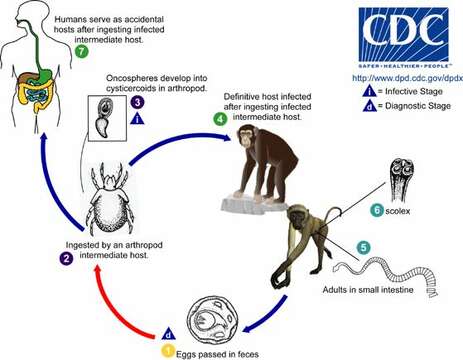Life cycle of Bertiella tapeworms

Description:
Life cycle of Bertiella tapeworms
The life cycle of Bertiella species is not completely understood. Bertiella are believed to have two-host life cycles, with an arthropod intermediate host (usually a mite, likely an oribatid mite) and a vertebrate definitive host (usually non-human primates for the species implicated in human infections). Bertiella studeri (which is found in Africa and Asia) usually infects monkeys in the genera Anthropithecus, Cercopithecus, Cynomologus, and Macaca. Bertiella mucronata (which is found in South America and Cuba) usually infects monkeys in the genera Callicebus and Alouatta.
Bertiella eggs and proglottids are passed in the feces of the definitive host (1). Oncospheres (which contain the tapeworm larvae) are ingested by the arthropod intermediate host (2) and within this host the oncospheres develop into cysticercoid larvae (3). The definitive hosts become infected when they ingest arthropod intermediate hosts (4) infected with cysticercoids. Adult Bertiella reside in the small intestine of the definitive host (5), where they attach to the mucosa with the aid of an unarmed scolex (6) (the anterior end of a tapeworm's head). Humans can occasionally serve as definitive hosts for both B. studeri and B. mucronata, usually after accidentally ingesting infected mites (7).
From Centers for Disease Control Parasites and Health website
Included On The Following Pages:
- Life (creatures)
- Cellular (cellular organisms)
- Eukaryota (eukaryotes)
- Opisthokonta (opisthokonts)
- Nucletmycea
- Fungi (mushrooms, lichens, molds, yeasts and relatives)
- Dikarya
- Ascomycota (sac fungi)
- Dothideomycetes
- Pleosporales
- Massarinaceae
- Bertiella
This image is not featured in any collections.
Source Information
- license
- cc-by-nc
- copyright
- Centers for Disease Control/Division of Parasitic Diseases and Malaria
- publisher
- Shapiro, Leo
- photographer
- Centers for Disease Control/Division of Parasitic Diseases and Malaria
- provider
- EOL Rapid Response Team
- original
- original media file
- visit source
- partner site
- EOL staff
- ID


